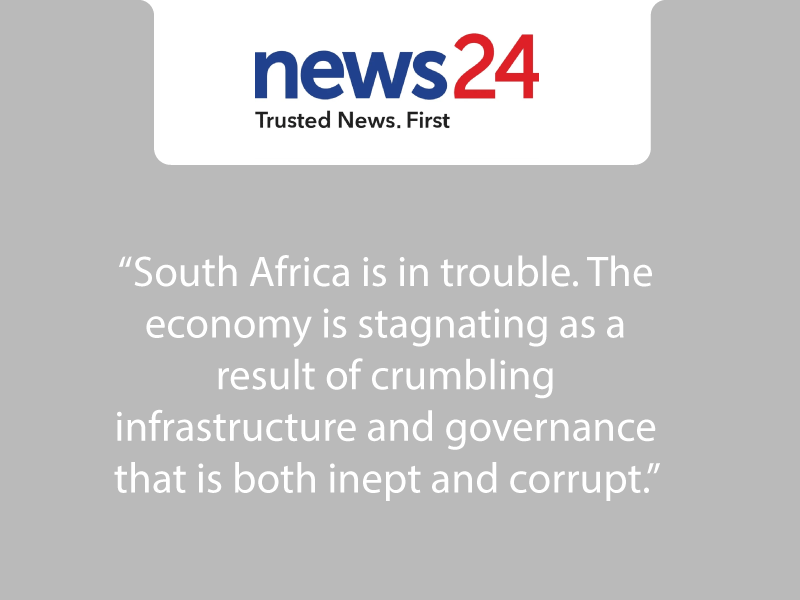
South Africa has some of the worst employment figures in the world. Nearly five and a half million people – one in every six adults – are out of work in South Africa. Unemployment at this level is one of the most important causes of poverty and inequality and contributes to political instability. Unemployed people are more likely to be tempted into crime or to respond violently to the pressures caused by population growth and poor service delivery. Worst of all, unemployment is a terrible waste of human potential and a continued assault on human dignity.
Almost every unemployed person could and should be doing productive work that would improve their lives and develop the country.
The South African economy performed well by its own unexciting standards from 2001 to 2008, and particularly well from 2004 to 2008, when unemployment fell by nearly five percentage points. This was a significant improvement, but our unemployment rate was still very high. In March 2009, the official unemployment rate was 23,5%. The global recession has led to South Africa losing over a million jobs since then so that now some 25,2% of the labour force is unemployed. If discouraged work-seekers are included, the unemployment rate for the first quarter of 2010 stands at 32,5 per cent. (Statistics South Africa has recently re-defined what it is to be ‘discouraged’ which has brought this percentage down from close to 40%.)
The truth is that our economic performance before the onset of the global recession was far from impressive by emerging market standards. In the decade after 1994, South Africa’s GDP per capita grew by only 1,2 per cent a year, compared to 3,7 per cent in South Asia and 6,2 per cent in East Asia. Our non-mineral exports actually shrank.
Some of the reasons for this were beyond our immediate control – exchange rate instability; skilled labour shortages; and our highly specialised and rigid industrial capacities. But badly thought out and co-ordinated economic policies were also an important part of the story. We achieved macro-economic stability, but did little to improve our competitiveness. If anything, we became less competitive in some areas. Slow job-creation was, therefore, inevitable.
The government’s Expanded Public Works Programme has created a relatively small number of temporary part-time jobs. A larger second phase has just begun. Although some criticisms of the first phase have now been addressed, the current programme is unlikely to make a sustained long term impact on the scale of unemployment.
The welfare system will not be able to address the needs of the unemployed. There were only 5,6 million individual taxpayers in 2008/09, most of whom paid very little tax. By contrast, there are currently 13,8 million people drawing social grants. The latter figure is expected to rise to 15 million by 2011 – 2012.We already have the most generous redistributive welfare system in the global South. We cannot afford to expand it any further and especially in the current economic climate, and in the absence of major growth in productive capacity. Even if we could grow the welfare net, for every taxpayer, we would have three social grant beneficiaries and one able-bodied unemployed adult wanting to work. This is simply unsustainable.
Jobs provide self-respect, independence, and fulfilment. Productive work is the bedrock of democracy and human development. South Africa needs jobs; and it needs them more urgently and in larger numbers than ever before.
New thinking required
In 2008 and 2009 the Centre for Development and Enterprise and Business Leadership South Africa brought together some leading South Africans to think afresh about the causes of unemployment and about new job creation strategies, so that every South African who needs a job will be able to find one.
Anticipating President Zuma’s call for a vigorous debate on this issue, we asked participants to leave their existing certainties and loyalties at the door. This was far from easy, but during several long conversations the group found its way to three shared views. We agreed that:
- Times are tough, but we have tackled bigger challenges in the past; we can do it again. Despite our diverse backgrounds, we share a commitment to decent lives for all.
- We cannot continue with ‘more of the same’. Policies that failed to reduce unemployment during the most sustained economic boom of our lives will not work during the biggest slump any of us have ever known.
- We need to stop talking about what we believe ought to be done. None of us knows for certain whether our pet project or favoured remedy will work, and no amount of theoretical discussion will decide the matter. We need to start experimenting with a variety of policies and programmes, and see what actually works.
Aiming to create millions of new jobs is not something that should be based on theories. We should be thinking town-by-town, city-by-city and province-by-province about what exactly we could try.
Take KwaZulu-Natal as an example. With about one fifth of the country’s population our proposals could – with determined leadership and effective public private partnerships – lead to about one million jobs in about five years. How? Expand the existing Richtek vocational training programme at Richards Bay to other metros and large towns. Expand KwaZulu-Natal’s labour-intensive rural road construction programme. Use the Development Facilitation Act to set up new globally competitive industrial development zones (SEZ’s) near Durban, Richards Bay and LaMercy/King Shaka airport. Develop three new world-class ‘must see’ tourist attractions, including a game reserve and marine resort on the ‘Bluff Headlands’. Expand SA Sugar Association’s Inkezoland company model for incubation and support of black farmers into other agricultural sectors. Couple this with a state commitment to settle all remaining land claims in one year and we could boost established sugar and forestry businesses.
The challenge is to create jobs for the people we have now, not the highly skilled individuals we hope to have one day when our education system is vastly improved. Converting our massive unemployment problem into a low wage problem would be an important step forward, especially if it was coupled with fast growth that would soon start to push wages up.
Our crisis, after all, is deep and demands urgent action. Most young South Africans are unemployed. Most young work seekers have never had a job, and in areas like Polokwane, for instance, some 80 per cent of young women under 20 have never been employed.
According to Stanford University professor and top growth economist Paul Romer: “Poverty and inequality are not an argument against trying to arrange a deal where people get jobs that pay a relatively low wage. A low wage is better than no wage. Just being in a job helps develop new skills. It should therefore be a high priority to push with all available tools to reduce unemployment levels.” What we want to do is get more firms competing for workers. Not only will they find a job, but all that competition means wages will rise. Certainly, the problems created by prolonged mass unemployment are far worse than any conceivable difficulties that might be caused by large numbers of people earning relatively low wages.
The essential economic policy priority must be to encourage the creation of more jobs. Every other economic goal and policy should be tested by whether it helps to generate jobs. Not ‘make work’ jobs but economically viable employment. If it doesn’t, we should dump it.
Focus on young people and on creating real jobs in specific places.
Young people are – or are believed to be – less productive than more experienced workers. Employers are therefore less likely to take a chance on hiring them. On the other hand, young people are the quickest learners. Skills acquired in youth are ingrained in ways that later training battles to replicate. This is a good reason to focus our efforts on the young.
The best way to tackle unemployment at scale would be to change the factors which are preventing labour markets from functioning efficiently. Given the entrenched opposition to this approach, however, we have developed – as a second-best approach – some specific ideas for tackling the problem of youth unemployment. These ideas have been chosen for their potential to stimulate debate in a policy area that is sorely in need of new ideas and fresh approaches. It will become easier to make a case for broader changes once it becomes obvious that deregulation and business-friendly policies within the special zones and among exempted young people do lead to real improvements in the lives of young and poor South Africans.
Experiments
On the basis of a careful survey of domestic and international experience, we developed the following four proposals:
- Give a combination of tax breaks and year-long exemptions from laws on hiring and firing to employers hiring first-time employees between the ages of 18 and 24. A wide range of international experience has shown that these policies can be successful in reducing youth unemployment, especially when vocational training is also available, and when both employer bodies and unions are involved in the design and implementation of the programmes. In South Africa, it has been shown that once a young person has found their first job, they are very likely to stay in employment. Therefore, policies like these stand a good chance of having permanently positive effects. They should be piloted in core business districts such as those in Gauteng. We were pleased to note that in his Budget Speech in February 2010, Minister of Finance, Pravin Gordhan announced that government was planning to institute a wage subsidy for young workers.
- Create Special Economic Zones (SEZs). International experience shows that SEZs are particularly effective in creating employment for young people and young women in particular. Because unemployment is highest for young people – and highest of all for young women – SEZs are a very attractive option. Businesses that locate in these zones should be exempted from costs like company taxes, tariffs, and all but the most basic labour, health and safety laws. Government should undertake to provide these zones with effective services and infrastructure, and to monitor how many young people find jobs in them. Different patterns of incentives and exemptions should be tried in different SEZs – for instance, one zone could emphasise excellent infrastructure; another could provide subsidised housing and transport for workers; a third might offer a particularly generous tax holiday. We should experiment to see what works best.
- Pilot a vocational education programme linked to apprenticeships in some of South Africa’s rapidly growing medium-sized towns, such as Nelspruit and Witbank. South Africa has the unusual double problem of mass unemployment and a shortage of skilled workers. One major reason for this is a mismatch between what the schools are producing and what employers require. Our education system provides much less vocational education than most other countries. South African student participation in technical and vocational education and training is half that attained by countries with a similar per capita income. We need to start creating a much larger and more effective vocational education stream in high schools. We should begin by piloting vocational education in the relatively manageable context of some of South Africa’s fast growing medium-sized towns, where we can gain experience in linking local companies with the schools that should be providing their workforce. Companies in those towns should become directly involved in deciding the curriculum within vocational education streams. In this way, they would be able to link particular programmes to on-the-job training opportunities, after-school apprenticeships and ultimately, permanent jobs.
- Create large and very simple employment schemes in the poorest provinces, such as Limpopo and the Eastern Cape. These schemes should guarantee dignified and useful employment (building roads, providing basic social services) for every person who applies to them. Wages should be set at a level that would guarantee subsistence; ensure that only the poorest and most in need of a job would apply; and keep the fiscal demands of the scheme to acceptable levels. These schemes should be regarded as temporary initiatives while we remove the regulatory barriers and address the educational and infrastructural constraints that make it difficult for private companies to create jobs for everyone who wants to work.
South Africa’s challenge
The only way to discover exactly how the kinds of policies we have advocated here would work in specific South African situations is by trying them out. Given the current reality that we face both short and long-term employment crises, complacency and sticking with what hasn’t worked in the past should no longer be an option. While sectional interests may oppose these proposals, it is clear that there is a far greater national interest in addressing youth unemployment. All interests can and should commit themselves at least to experimenting with the ideas suggested here.
Every year, hundreds of thousands of young South Africans enter the labour market. If current trends continue, most of them will not find work. It’s time to have a much more urgent, practical and frank conversation. In Jayendra Naidoo’s words we need a ‘patriotic debate’ about South Africa’s greatest national challenge.
As James Mahlatsi, Jayendra Naidoo and I have argued: “If you disagree with our proposals, don’t just write us off, or tell us you don’t like our ‘ideology’. Give us detailed reasons why we are wrong and, make alternative suggestions that are affordable, implementable, don’t have major unintended consequences, and have the potential to create jobs for millions of South Africans.”
- Ann Bernstein is the executive director of the Centre for Development and Enterprise.




